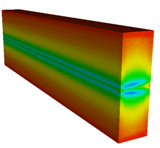Speaker
Description
At the ILC, the removal of halo particles having large amplitudes relative to the ideal orbit is mandatory to both minimise damage to beam line elements and particle detectors and to achieve tolerable background levels in the latter. In the high energy, high intensity environment of the linear collider the low background levels will largely be ensured by placing a set of mechanical spoilers/absorbers very close to the beam. This presents two significant problems: (i) short-range transverse wakefields excited by these collimators may perturb beam motion and lead to both emittance dilution and amplification of position jitter at the IP, and (ii) impact of even a small number of bunches at the expected energy densities can damage the spoilers. Simulations were completed to determine the energy deposition of an ILC bunch using FLUKA, Geant4 and EGS4 to a set of different spoiler designs. These shower simulations were used as inputs to thermal and mechanical studies using ANSYS. A test proposal is under preparation to optimise the material choice and mechanical design of ILC spoilers jaws using ATF and benchmark the energy deposition simulations and the ANSYS studies. Measurements of the transverse wakefields induced by collimators of differing geometries were performed at the End Station A of SLAC. The trajectory of the beam upstream and downstream of the collimator test apparatus was calculated from the outputs of ten BPMs (four upstream and six downstream), thus allowing a measurement of the angular kick imparted to the beam by the collimator under test. The transverse wakefield was inferred from the measured kick. The different aperture designs, a preliminary analysis of the collected data and comparison to theoretical and analytic predictions are presented here.




